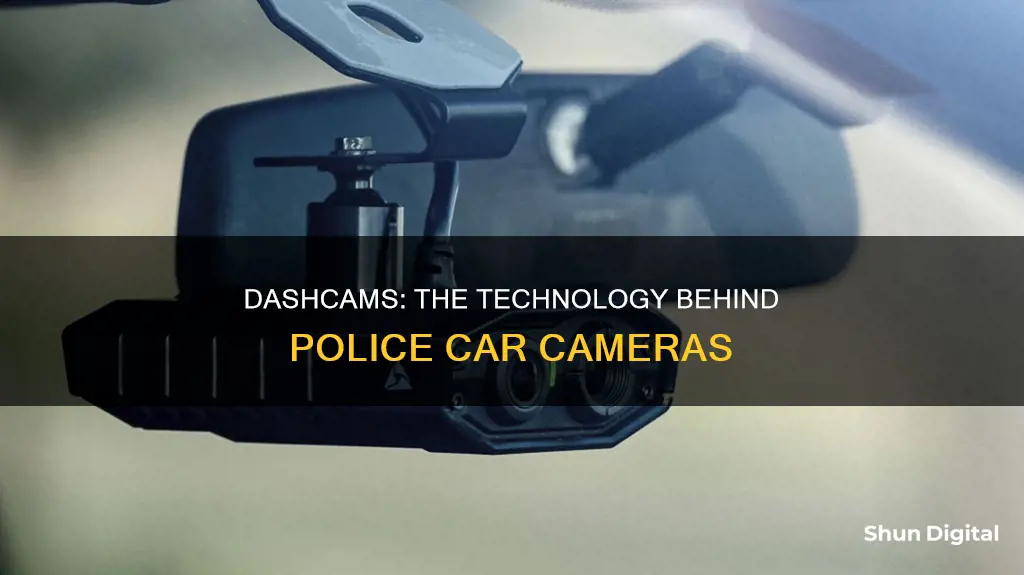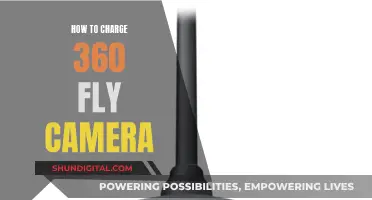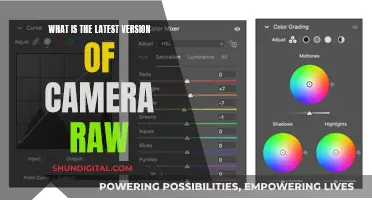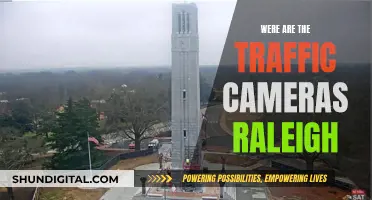
Police car cameras have become increasingly common in recent years, with technology playing a bigger role in law enforcement. These cameras are usually hardwired into a vehicle's electrical system and can be triggered by events such as an officer turning on their emergency lights and siren, or reaching a certain speed. They are designed to improve safety for both officers and citizens, providing an objective record of incidents and helping to de-escalate situations. In addition, they can be used for training purposes and to increase transparency and accountability. The cameras can also assist in gathering evidence, such as scanning license plates, and have been shown to aid in locating and convicting criminals.
| Characteristics | Values |
|---|---|
| Purpose | To provide an independent, objective record of what the officer encounters |
| Position | Mounted on the trunks or roofs of police cruisers |
| Function | Captures video and audio footage of incidents |
| Activation | Can be manually activated by an officer or automatically triggered by certain events, such as turning on emergency lights and siren |
| Benefits | Evidence collection, officer safety, community transparency, liability protection, training, and de-escalation |
| Features | Automatic license plate recognition (ALPR), dual-view, interior cameras, real-time data sharing, wireless microphones, body-worn camera pairing, live alerts and streaming, high-capacity storage |
What You'll Learn
- Cameras provide an objective account of incidents, protecting both citizens and officers
- They can be automatically activated by triggers, such as emergency lights
- Dashcams can be used for training, with officers reviewing footage for self-improvement
- Cameras with automatic license plate recognition can help locate stolen vehicles
- Recordings can be used as evidence in court, aiding in convictions

Cameras provide an objective account of incidents, protecting both citizens and officers
In recent years, the world of law enforcement has seen a surge in new technologies, including police car cameras, body cameras, and high-tech squad cars. These advancements aim to keep both officers and citizens safe by providing objective accounts of incidents and protecting all involved parties.
One of the primary benefits of police car cameras is their ability to provide an objective and independent record of events. The cameras capture incidents from the perspective of the police vehicle, giving a broader view of the situation than body-worn cameras, which are limited to the officer's point of view. This objective footage can be crucial in protecting both citizens and officers by providing clear evidence of what transpired.
For citizens, police car cameras offer an additional layer of protection and accountability. The presence of these cameras helps deter misconduct and ensures that officers are held accountable for their actions. In the event of complaints or disputes, the footage can be reviewed to determine the facts objectively, leading to increased transparency and trust in law enforcement.
Police car cameras also safeguard officers by providing evidence that can exonerate them from false or misleading complaints. The cameras capture interactions between officers and citizens, helping to protect officers from potential harm and unfounded accusations. This aspect of the technology is particularly important in situations where there may be no other witnesses or recordings to corroborate the officer's account.
Furthermore, police car cameras have evidentiary value in criminal investigations and court proceedings. They can capture crucial footage of incidents, such as traffic stops or high-speed chases, which can be used as admissible evidence to aid in convictions. The cameras also assist in locating suspects and gathering critical information during investigations, contributing to the overall effectiveness of law enforcement.
In conclusion, police car cameras play a vital role in protecting both citizens and officers by providing an objective account of incidents. The cameras promote transparency, accountability, and safety for all involved parties. With the advancement of technology, law enforcement agencies can continue to enhance their capabilities and better serve their communities.
Focusing Your Camera in Monster Hunter Rise: Tips and Tricks
You may want to see also

They can be automatically activated by triggers, such as emergency lights
The use of police car cameras has become increasingly common in the world of law enforcement. These cameras are hardwired into a vehicle's electrical system, allowing them to be activated by specific triggers. One such trigger is the activation of emergency lights and sirens, which can automatically prompt the camera system to start recording. This ensures that every incident is recorded, providing an objective account of the situation.
The automatic activation of police car cameras based on triggers offers significant advantages to law enforcement agencies. Firstly, it guarantees that critical incidents are captured on camera, providing valuable evidence for investigations and prosecutions. This helps to protect both the officers and citizens involved, as the footage can offer an unbiased perspective of the events that transpired.
Additionally, the use of triggers ensures that cameras are activated even when officers are unable to manually turn them on. This addresses the issue of officers forgetting or being unable to activate cameras during high-pressure situations. By relying on triggers, law enforcement agencies can increase the likelihood of capturing important footage that may otherwise have been missed.
While automatic triggers are beneficial, it is important to note that not all dash cameras are activated in this manner. In some cases, officers still need to manually turn on the cameras. This may be due to technical limitations or agency policies that require officers to take responsibility for activating the cameras.
The integration of police car cameras with other technologies further enhances their capabilities. For example, the Pro-Vision in-car camera system can automatically trigger body cameras within a 30-foot range when the vehicle's lights or other triggers are activated. This simultaneous recording of in-car and body-worn footage provides a more comprehensive view of an incident.
In conclusion, the ability of police car cameras to be automatically activated by triggers, such as emergency lights, plays a crucial role in law enforcement. It ensures that critical incidents are recorded, providing valuable evidence and protecting both officers and citizens. While automatic triggers are advantageous, manual activation by officers still plays a role in certain situations, depending on the specific camera systems and agency policies in place.
Unlocking Camera Raw: A Guide to Activating the Feature
You may want to see also

Dashcams can be used for training, with officers reviewing footage for self-improvement
The cameras installed on police cars, or dashcams, have become increasingly common in police departments across the country. Dashcams can be used for training, with officers reviewing footage for self-improvement.
Dashcams are incredibly useful tools for police officers, as they can be used to enhance officer safety, reduce police department liability, provide transparency for the community, and improve conviction rates. They can also play a crucial role in officer training and self-improvement.
Departments can leverage dashcam footage to demonstrate good and bad police conduct. By reviewing the footage, officers can learn from their mistakes and observe positive behaviours and successful tactics. They can assess their response to specific situations and make necessary improvements, particularly regarding officer safety.
The ability to slow down video frames is also advantageous for training purposes. Officers can gain a better understanding of incidents by reviewing footage in slow motion, allowing them to make more informed decisions in similar situations in the future.
Additionally, dashcam footage can be used to identify successful police tactics and share them with other officers. This knowledge transfer can help improve the overall performance of the department and ensure that officers are employing the most effective strategies.
The use of dashcam footage for training purposes can also help promote a culture of continuous improvement within police departments. Officers can regularly review their footage to identify areas for self-improvement and set performance goals. This proactive approach to training can enhance the skills and effectiveness of officers, ultimately leading to better outcomes for both the officers and the communities they serve.
In conclusion, dashcams are a valuable tool for police officer training and self-improvement. By reviewing dashcam footage, officers can identify areas for improvement, learn from their mistakes, and develop better tactics for handling various situations. This use of technology helps to promote a more skilled, transparent, and accountable police force, which benefits both the officers and the communities they serve.
Mastering Camera Modes: A Guide to Shooting in Manual Mode
You may want to see also

Cameras with automatic license plate recognition can help locate stolen vehicles
Cameras with automatic license plate recognition (ALPR) can be an effective tool for locating stolen vehicles and enhancing overall road safety. ALPR technology utilizes high-speed cameras, often mounted on street poles, streetlights, or police vehicles, to capture license plate numbers along with location, date, and time data. This information is then uploaded to a central server, allowing law enforcement to cross-reference plates against a database of stolen vehicles. The system can alert authorities when a match is found, enabling them to track the vehicle's movements.
One of the key advantages of ALPR is its ability to process a large volume of license plates quickly and accurately. These systems can capture thousands of plates per minute, even in challenging conditions such as low lighting, high speeds, or blurry images. This efficiency enables law enforcement to monitor a vast number of vehicles in real time, significantly increasing the chances of recovering stolen vehicles.
In addition to locating stolen vehicles, ALPR has other valuable applications. For instance, it can be used to identify vehicles associated with criminal activities, such as those seen at the scene of a crime or belonging to suspects. ALPR data can also assist in historical investigations by providing insights into a vehicle's past locations, helping to piece together movement patterns and placing suspects at specific places.
While ALPR offers significant benefits, it is important to acknowledge privacy concerns. The extensive collection of license plate data allows authorities to track the movements of millions of ordinary citizens, raising questions about government surveillance and potential misuse of information. To address these concerns, regulations and policies regarding data retention, access, and privacy have been implemented in various jurisdictions.
In conclusion, cameras with automatic license plate recognition are valuable tools for law enforcement, particularly in locating stolen vehicles and investigating crimes. However, the use of this technology must be balanced with the need to protect civil liberties and ensure that data collection practices are ethical and transparent.
Fight Traffic Camera Tickets: Your Legal Options
You may want to see also

Recordings can be used as evidence in court, aiding in convictions
In the last two decades, there has been a surge in the use of technology in law enforcement, with police car cameras, body cameras, and high-tech squad cars becoming more common. These technologies are designed to keep both officers and citizens safe. In 2000, only 11% of state police and highway patrol vehicles had in-vehicle camera systems, but now, almost 72% of all state patrol vehicles use this technology.
Recordings from police car cameras can be used as evidence in court, aiding in convictions by providing an objective and independent account of events. This footage can be used by prosecutors and defense attorneys to show officers' interactions with victims, witnesses, and defendants, offering a detailed, firsthand account of a police encounter. This increases transparency and accountability, allowing for the verification of an officer's testimony and justifying their actions.
For example, in the case of Reyna v. State, 2017 Tex. App. LEXIS 6202, at *10 (Tex. Ct. App. July 6, 2017), dashboard camera footage was used to corroborate an officer's testimony that a traffic stop was supported by reasonable suspicion. Similarly, in City of Topeka v. Murdock, No. 116, 213, 2018 Kan. App. Unpub. LEXIS 12, at *7 (Kan. Ct. App. Jan. 12, 2018), body camera footage depicted the defendant giving consent to an officer's search, meeting the consent exception to the search warrant requirement.
The use of police car camera recordings as evidence is subject to certain rules and legal considerations. For instance, video recordings must be authenticated by a witness with knowledge of the contents before being admitted as evidence. Additionally, trial judges must consider the potential prejudicial effect on the defendant and whether the footage contains hearsay statements.
Overall, the use of police car cameras and the resulting recordings has revolutionized law enforcement, providing valuable evidence that can aid in convictions and increase transparency and accountability in the justice system.
Choosing the Right Spot for Camera Surveillance
You may want to see also
Frequently asked questions
The cameras on police cars are called dash cams and they are used to record video evidence, provide additional visibility for officers and supervisors, and allow for greater community transparency.
Police car cameras have several benefits. They help keep officers safe, provide valuable training material, improve transparency and accountability, protect officers from false or misleading complaints, and provide evidentiary value.
Police car cameras are hardwired into the vehicle's electrical system and can be activated manually or through pre-programmed triggers. For example, a camera may automatically start recording when a police officer turns on their emergency lights and siren.
Those accessories are cameras used for an automatic license plate reader (ALPR) system. They snap pictures of license plates and the system checks them against local, state, and federal databases to identify vehicles of interest, such as those with registration issues or associated with an All-points Bulletin (APB).







